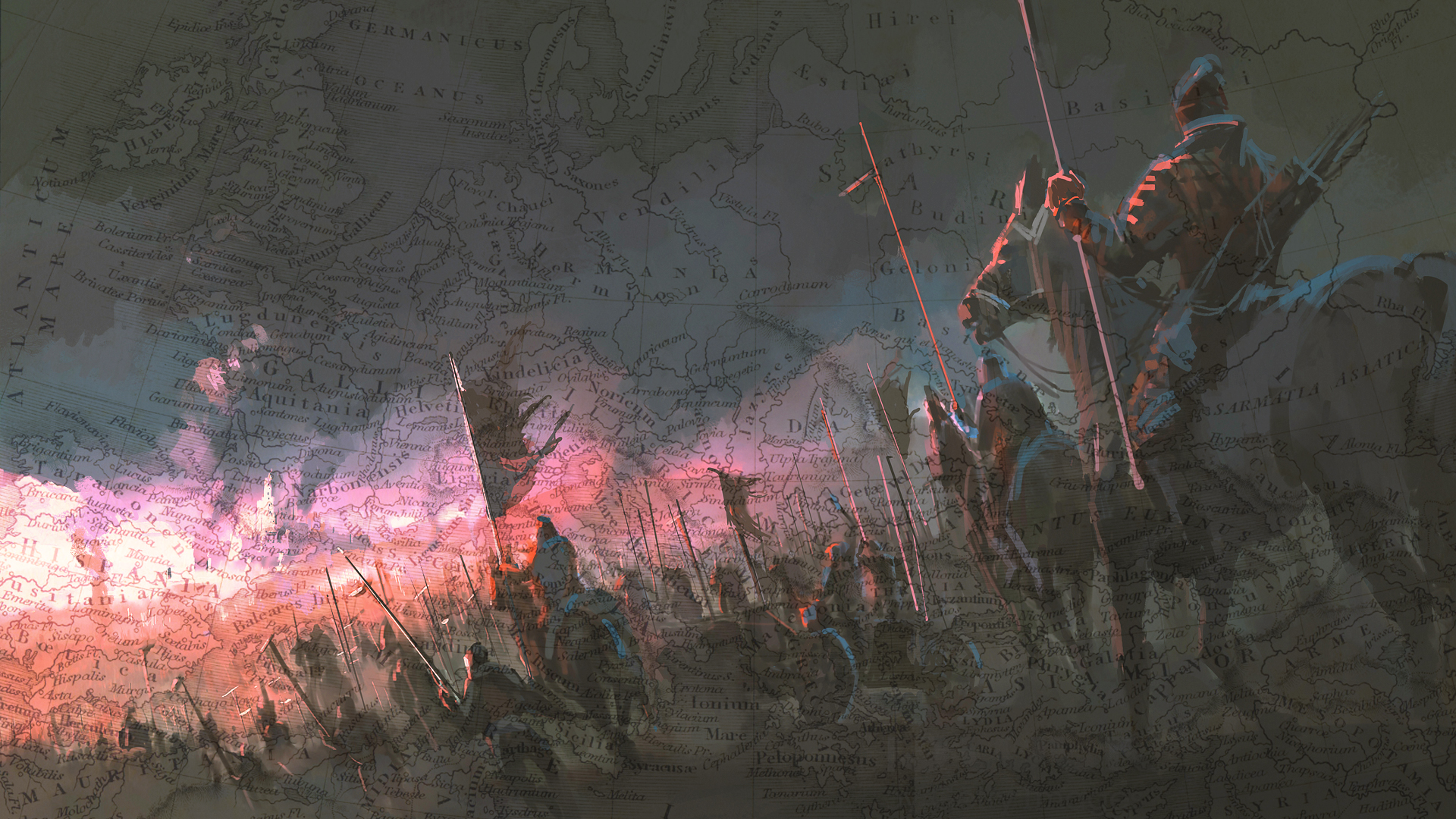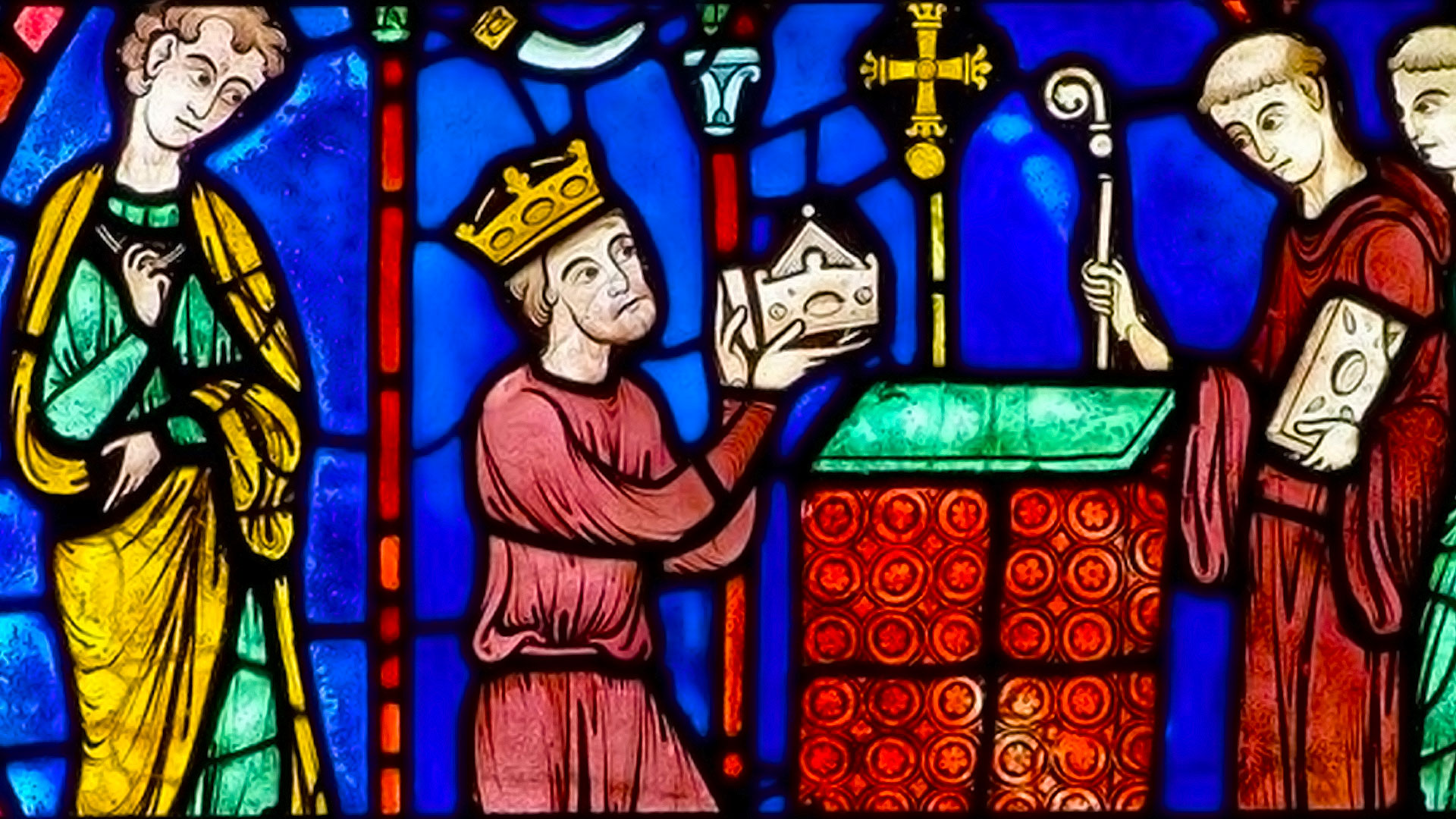Empire-Building, Then and Now
What are some of the lessons we can draw from the way empires have arisen through the ages?
Unity is generally a good thing. But while millions may find a degree of unity on a single issue, we’ve never come close to global agreement on all issues.
Perhaps the most successful model for bringing the masses under a single banner has been empire. Yet the very fact that empires come and go suggests that the unity they achieve falls short. How have history’s empires risen to power, and what does it say about our nature as human beings?
A scan of some of the shared aspects of the Babylonian Empire, the Roman Empire, the British Empire and what some have termed the American Empire offers clues.
Characteristics of the First Empires
The idea of forging empires began in the third millennium BCE in ancient Mesopotamia, which today roughly comprises Iraq, northern Kuwait, eastern Syria and southeastern Turkey. Lower Mesopotamia was the land of Sumer, or Shinar, home to the Sumerians.
Empires in this region—Akkadian, Old Babylonian, Assyrian—arose in context of the military might to conquer other peoples and territories. But by the seventh century BCE, these had all given way to the Neo-Babylonian Empire of the Chaldeans.
While empires may be forged through military might, ready opportunities for trade can help galvanize them by generating prosperity. In Mesopotamia a vast network of canals not only took water to crops but enabled the transport of goods. Egyptologist David Rohl observes that the word market in Akkadian, karum, is also the word for the quaysides where saleable goods were unloaded.
Also central to any unity between disparate peoples and ideas is a sense of shared identity, and religion is a powerful means of creating that common identity. On those same commercial waterways of Mesopotamia, statues of the gods traveled throughout the region in sacred barges to “visit” each other on certain festival days. The gods were believed to have their terrestrial homes in temples atop ziggurats. They received goods from the people as a form of taxes, which were then redistributed by a priestly bureaucracy. Trade and religion were thus intertwined as roots of empire from the beginning.
Imperial expansion and the resulting proliferation of goods passing through the temple system required the establishment of extensive and sophisticated administrative infrastructure to keep track of the movement of wealth. British writer and documentary filmmaker Paul Kriwaczek noted that Babylon built “a financial system recognisably related to our own, featuring banking and investment, loans, mortgages, shares and bonds, trading companies and business partnerships.”
“This was history’s first experiment in mercantilist capitalism, with all its consequences, negative as well as positive.”
The Babylon of the Chaldeans accrued astonishing wealth, but the envy this fostered made it a target. Babylon would fall to the swords of the Persian Empire. In turn Persia would fall to the Macedonians, whose Greek iteration of empire would itself be swallowed up by Rome.
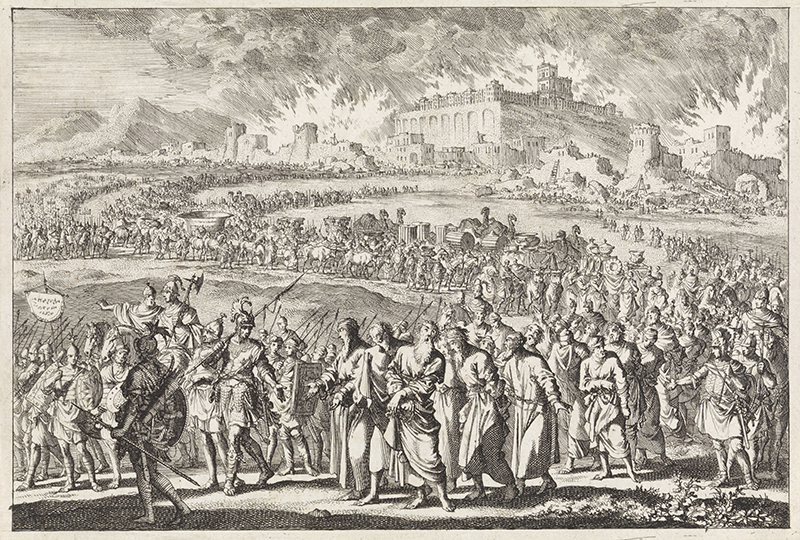
The Destruction of Jerusalem by the Babylonian Army by Jan Luyken (1700). After the siege of Jerusalem, the Babylonian army heads home with the city’s plundered treasures, taking its inhabitants captive as slaves. In the background, Jerusalem is in flames.
The Iron Brand of Roman Imperialism
The builders of the Roman Republic, which gave way to the Roman Empire in 27 BCE, had no grand vision for world domination. Conquests were more about conquering peoples than territories. At least at first, Romans were focused on establishing obedience by force and incorporating new troops into their army, not on wholesale annexation, occupation and tax collection. Yet as Rome grew, it created an ever greater imbalance of power as smaller states vied to have Rome on their side in local disputes.
Rome, like Babylon, established its vast empire with the sword. Also like Babylon, maintaining it required more than just brute force; it required collaborators—the forging of new connections, often through trade. But trade always favored the victors. New conquests meant access to new markets, and as the empire expanded, Roman traders were keen to exploit these far-flung new commercial opportunities.
Still, while collaboration and trade helped maintain cohesion, violence (or the threat of it) remained an important tool. Rome was not unique in this, of course. Historian Stephen Howe remarks that empire was “often, indeed perhaps typically, established and maintained by violence. Sometimes extreme violence: some historians would say that most episodes of genocide and mass murder in world history have been associated with empire-building.”
Also perhaps typically, new imperial masters often view conquered peoples as inferior. As Howe puts it, “In modern imperial systems (and perhaps in many ancient ones too). . . , it was typically believed that the dominant people were clearly culturally different from, and superior to, the politically subordinate, peripheral ones.”
The perceived superiority of conquerors is often upheld on the basis of a divine manifesto. In the case of Rome, fictional accounts of divine foundations were only later woven into the fabric of historical origins. One such origin story concerned the mythical hero Aeneas. Returning from the Trojan War, he encountered the messenger god, Mercury, who had a message from Jupiter, king of the gods: Aeneas’s destiny was to found Rome. Arriving in the Italian countryside, Aeneus therefore had nothing less than a divine mission to initiate the Roman project, or so the story runs.
A sense of manifest destiny thus grew with the idea of Imperial Rome and justified Roman conquests. Historian Mary Beard notes: “Many Romans insisted that their overseas expansion resulted from a series of just wars, in the sense of wars undertaken with the necessary support of the gods, in self-defence or in the defence of allies, who had often solicited Rome’s help. It was not aggression at all.” This suggests that when an empire claims a divine mandate, then the more powerful it becomes, the more infallible it will perceive itself to be.
Once the Roman Empire adopted a form of Christianity, conquest took on a moral dimension whereby Rome’s perceived authority was boundless. Thus, although the barbarians sacked Rome in 476 CE, imperial conquest lived on in the form of the Holy Roman Empire.
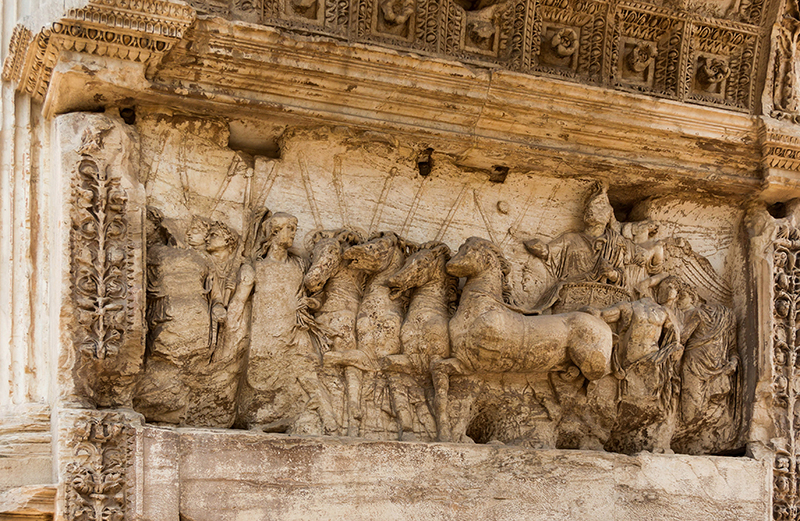
Detail from the Arch of Titus, erected after the emperor’s death in 81 CE, to commemorate his Judean conquests and the sacking of Jerusalem. In this relief panel, Titus drives a chariot while being crowned by the goddess Victory.
A Very British Empire
When Rome adopted Carthaginian designs for a navy, it gained a means of both shipping essential grain from North Africa and striking at enemies from the sea. The world is more ocean than land, after all—a fact that British imperialism would later exploit via its own navy.
Given the fearsome reputation that Britain’s official navy built over time, we might assume it was the British government that conquered India, the jewel in its imperial crown. The truth is more bizarre, however. In the words of Scottish historian William Dalrymple, India was conquered by the brute force of “a dangerously unregulated private company headquartered in one small office . . . in London”—the East India Company (EIC). The EIC’s founding charter allowed it to wage war to achieve its commercial ends. At its height, its army was approximately double the size of the British army. It also shipped narcotics (opium) to China and seized Hong Kong.
Dalrymple notes that the EIC “reversed the balance of trade, which from Roman times on had led to a continual drain of Western bullion eastwards.” By the mid-19th century, “the shady, brutal and mercantile way the British had founded the Raj” had become an “embarrassment.” Dalrymple writes: “Finally, on 10 May 1857, the EIC’s own private army rose up in revolt.”
“The Company distinguished itself for a final time by hanging and murdering many tens of thousands of suspected rebels in the bazaar towns that lined the Ganges, probably the bloodiest episode in the entire history of British colonialism.”
In 1859 the British government curtailed the EIC, handing off its army and its Indian possessions to Queen Victoria. Summing up the entire episode, Dalrymple cautions: “We must never forget that, in the final analysis, our empire was built by the sword and erected over the dead bodies of tens if not hundreds of thousands of our Indian subjects.” In addition to this human cost, economist Utsa Patnaik has estimated that, at 2017 currency values, the British extracted nearly US$45 trillion from India between 1765 and 1938.
As with earlier models of empire, the conquerors’ sense of their own superiority helped them justify their actions. The British Empire set up “protectorates” for those grateful recipients who, it suggested, were literally begging to come under its umbrella.
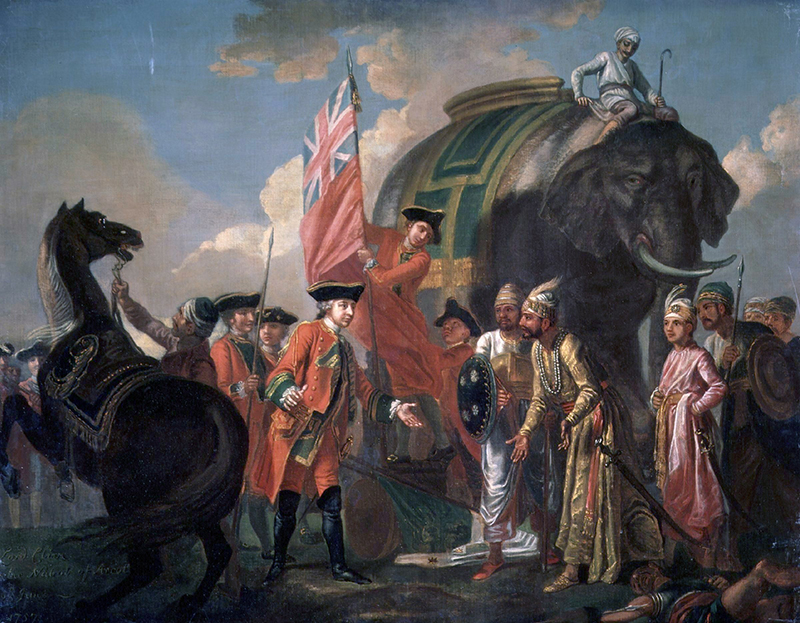
Robert Clive and Mir Jafar After the Battle of Plassey by Francis Hayman (1757). The Battle of Plassey established the East India Company as a military as well as commercial power.
An Elusive American Empire?
With the passage of time the ingredients for building an empire may have changed in particulars, but perhaps not in essentials.
Those living in the pre–World War II mainland United States would arguably have struggled to believe that their nation was presiding over millions of people in overseas colonies. On paper it was the fifth-largest empire in history (by population) at the time of Japan’s attack on Pearl Harbor, writes historian Daniel Immerwahr. He cites a World War II–era US government report stating that “most people in this country, including educated people, know little or nothing about our overseas possessions. . . . Americans are sometimes amazed to hear that we, too, have an ‘empire.’”
Like other empires, he notes, this one’s territory grew largely by superior might: Native Americans dispossessed of their land, with many killed or removed to reservations; an 1840s war with Mexico in which the United States seized a third of that country; and the 1898 Spanish-American War, which led to the acquisition of many of Spain’s possessions, including Puerto Rico, Guam and the Philippines.
“Adding up the land under U.S. jurisdiction—colonies and occupations alike—by the end of 1945 the Greater United States included some 135 million people living outside the mainland.”
Yet while empires were historically defined by the acquisition of new territory, what happened after World War II makes the United States a prime example of the modern imperial model. Puerto Rico became a “commonwealth,” and Hawaii and Alaska became states. But the US also took the unconventional step (for a victor) of giving up land by granting the Philippines independence.
This may seem antithetical to the idea of empire-building, and in fact the reasons were wide-ranging—from an anti-colonialism sentiment among some at home, to fear of increased numbers of Asian immigrants to the US mainland, to political opposition to the incumbent president.
But another reason for disposing of land may be linked to the fact that the postwar United States held the world’s most advanced technology portfolio, allowing it to operate a remote empire in which possession of as much overseas territory as possible wasn’t essential and even had drawbacks. Immerwahr observes that airplanes could move US goods around the world, and radio and telephone could communicate ideas without the need for annexation. Products and practices could be standardized to roll out across borders: “They replaced colonization with globalization.” Immerwahr sees globalization as the result of “a short burst” of military-led technological advancement in the 1940s, combined with a “world-spanning logistical network that was startling in how little it depended on colonies,” making for “a new relationship to territory.”
That doesn’t mean America didn’t retain territory. As well as overseas possessions, home to millions, Immerwahr highlights the hundreds of military bases the United States maintains around the world. These multiple small points on the map—close to 800 installations spread across roughly 80 nations and territories, which “serve as staging grounds, launchpads, storage sites, beacons, and laboratories”—make up what he calls a “pointillist empire.” The strategic empire of the United States has just the right amount of international territory to remain relatively imperceptible, while protecting its interests and dominating a globalized world founded on the twin pillars of commerce and digitization. For decades it was protected by US president Harry S. Truman’s doctrine affirming American intervention anywhere in the world where its interests were threatened.
The model has undoubtedly been a success, if wealth generation and influence are the measures. While Mesopotamians used cylinder seals to identify their goods sold into the empire, today Ronald MacDonald’s face and the Apple logo are instantly recognizable in most corners of the world. Many of the largest and most successful corporations on earth originated in the United States, and several have conquered the globe in the digital sphere— Apple, Amazon, Alphabet (Google’s parent company), Microsoft and Meta (formerly Facebook), among others.
“The geography of the American Empire was built partly on military relations but heavily on economic relations. . . . As the system matured, the value of investments soared along with the importance of imports, exports and labor markets.”
As with Roman and British imperialism, the American brand also had roots in a sense of divine destiny. During the 19th century, the concept of manifest destiny promoted the ideas of American exceptionalism and Romantic nationalism—belief in the innate superiority of the American settlers, that the West would be remade in the image of the agrarian East, and that it was their divinely ordained destiny to achieve that.
In an allegorical work, painter John Gast depicted a giant godlike woman, Columbia, as a manifestation of the United States. Lady Columbia would gradually be replaced as a national symbol by Lady Liberty, the famous statue that may have been based, in part, on the Roman goddess Libertas. The statue’s full title is Liberty Enlightening the World, and she carries a representation of the declaration of independence. In Gast’s painting, Columbia is shown carrying a book and stringing telegraph lines while bringing light, transportation and commerce from East to West.
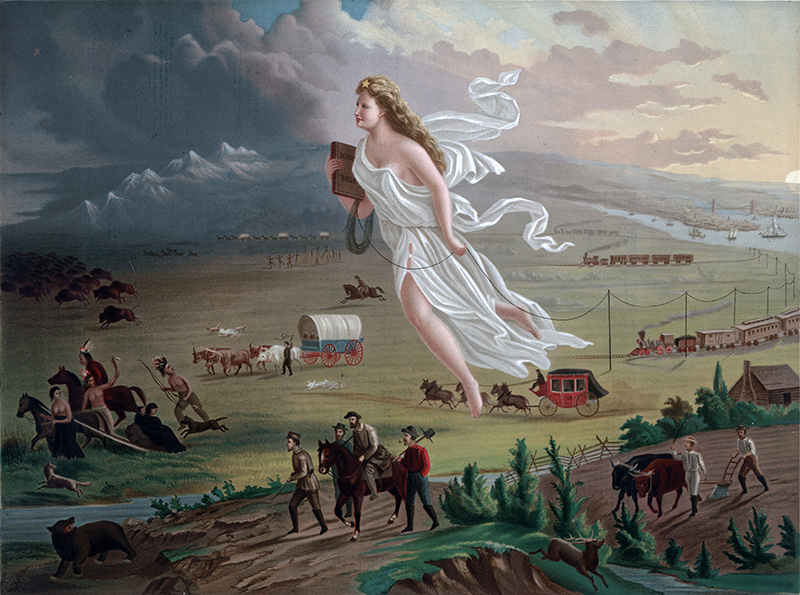
American Progress by John Gast (1872) depicts the idea of Manifest Destiny. Settlers move westward, guided and protected by the godlike figure Columbia (representing the United States). They bring with them such modern technologies as the railway and the telegraph while driving Native Americans and bison from the land. Columbia, the painting suggests, is bringing America’s enlightened East to a darkened West.
Inescapable Imperial Facts
Empires can bring law, order, wealth, technology and a degree of protection to those they envelop. They can also bring material, social and cultural advantages to both conqueror and conquered. Yet in every case, power is on the side of the empire, a power that at times has been intimately bound up with genocide, enslavement, theft, exploitation and/or oppression.
The primary beneficiaries of empire are always the same. They are the architects of the empire, often operating with naked aggression; unchecked power, greed and hubris; or the illusion that they are performing moral, selfless or even holy work to the glory of the gods and for the benefit of their fellow man.
In the face of these realities, empires can behave well or badly. One may be better or worse than another, but their prevailing track record remains poor. To understand why, we need to recognize that the idea of empire—the desires that bring them into being—originates not in the physical phenomena that characterize them, nor in the claim of a divine edict, but in the self-interested nature of the human heart. And while self-interest rules the day, unity will remain elusive.

